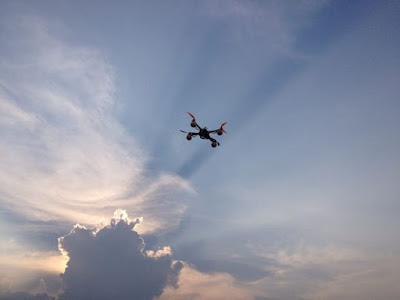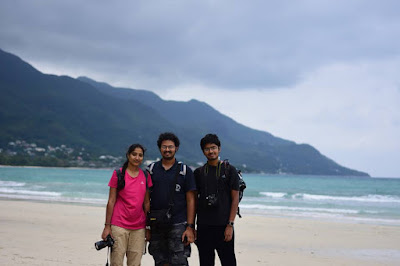 |
| The Dasaswamedh ghat with rainfall in the background. Varanasi. |
Uttar Pradesh is India's most populous state. If it were a country by itself, it'd rank somewhere in the top few most populous nations in the world. It's also one of India's most fertile lands and also one of the least developed. It's fed by two of India's largest rivers, the Ganga and the Yamuna, which merge at the Triveni Sangam in Allahabad. This state is also home to the most holy place for Hindus and one of the oldest cities in the world, Varanasi. This was also the general area where the Buddha attained enlightenment (Bodh Gaya in Bihar) and the sites of his first sermons. This state also saw the Delhi Sultans, the Rajputs, Marathas, the Mughals, the British and even the mutiny of 1857. Each of these regimes left their mark on Varanasi. This trip was an extended weekend trip to cover all this in one go. Also on the itinerary was the beautiful temple town of Khajuraho.
 |
| Amedkar Park, Lucknow. |
We started on 12 July from Bangalore, with a layover in Hyderabad. We booked the Plaza Premium lounge in HYD airport to have lunch and to lie around. We finally reached Lucknow at 6PM and took an Uber to a Treebo hotel in the Charbagh area of Lucknow and rested for the night after having the famed Lucknowi Biriyani. On the morning of 13th, we had the complimentary breakfast at the hotel and checked out. We then booked a 4 hour trip on Ola Rentals to tour the city.
 |
| Husseinabad, Lucknow. |
 |
| The Residency. Note the holes in the walls, due to cannon fire. Lucknow. |
 |
| Lucknow NE station. |
The first stop was one of the newest of the Mayawati's parks in Gomti Nagar, Ambedkar Park. There are three things that highlight her parks. Elephant statues, open spaces and her own statues. Ambedkar Park was the greatest park she built and had a corridor of 62 stone elephants leading to a place where a statue of herself was placed. There was also a museum depicting the life of Dr. B. R. Ambedkar. It was very hot and sunny and the park itself had few trees; mostly open land. We then headed to the Bada Imambara. Lucknow Nawabs were Shia and so built Imambaras and Husseiniyas to commemorate Moharram. The area itself was aptly called Husseinabad. The Bada Imambara was closed till 3PM as it was a Friday and so we couldn't get inside. We then moved on to Chota Imambara, which was 2 Km ahead, via the Rumi Darwaza. Chota Imambara's central sanctum is filled with chandeliers and lamps to be set alight on the 10th day of Moharaam. The watchman there was kind enough to show us around. We then moved onto the picture gallery, which was close by. It's got grand portraits of the nawabs of Awadh (as Lucknow was once called) and of the Delhi sultans to whom they once reported. We then moved to the Residency, which was the home of the British Resident in Lucknow and was also one of the sites of the 1857 mutiny. It was run over by the revolting sepoys in 1857 and it still has the holes in its walls which were created by cannon fire in 1857. The cab then dropped us at the railway station and we caught the Shatabdi to Kanpur after having a couple of parathas in a nearby restaurant. We reached Kanpur at 5PM and caught an Ola to IIT Kanpur to meet Shivam. He booked a guest room for us in the new RA Tower and had dinner with him and his co-founder, Harsha in the campus itself.
 |
| Triveni Sangam, Allahabad. |
We had the breakfast on 14th in one of the messes and went to visit Shivam's startup, Kritsnam Technologies Pvt. Ltd., which was being incubated in IITK. After talked to them about their work and sharing knowledge, we caught a cab to the railway station for our train to Allahabad. Once in Allahabad, we took a two hour Ola Rental to visit the Triveni Sangam. We returned back to the railway station after watching the sun set over the Sangam to have dinner at Hotel Polo Max and catch our train to Khajuraho.
 |
| Eastern group of temples, Khajuraho. |
 |
| Lakshmana temple. Western group, Khajuraho. |
We reached Khajuraho at 6AM on 15th and were picked up by an auto driver called Bhagirath. We stayed in Hotel Shanti near the western group of temples. There are a total of 24 temples in Khajuraho, the major ones being in the Western Group, which are clustered so well together that they can be visited on foot. The eastern group is spread out and covers pretty much the entire landscape to the east. Bhagirath took us for a tour of the eastern group first as it'd be impossible to walk to all of them. There's no entry fee for these and they look remarkably well maintained. The eastern group are not as erotic as the western group and are dedicated to the main Gods of the Hindu pantheon, such as Ganesha and Lord Vishnu. We returned to the hotel for lunch by noon. By looking at railway tracking apps, I figured that our overnight train to Varanasi is going to be short terminated in Allahabad. This gave a little concern as we had no idea what to do. So, we booked another train from Allahabad to Varanasi that departs Allahabad an hour after our train was supposed to arrive. Plan B was to take an Ola Outstation to Varanasi. The second half of 15th was spent walking around the temples of the western group, which were the main temples of Khajuraho, such as the Lakshmana temple, Viswanatha Temple and the largest one of them all, Kandariya Mahadeva. These temples are adorned with some of the most beautiful sculpting I've ever seen. They also treated sex as a tantric ritual and adorned the temples with exotic sexual poses and orgies. The Chandel dynasty of Khajuraho built about 80 temples on the whole and only these 24 survived down the centuries. We had dinner at the hotel itself and had Bhagirath drop us at the railway station at 8PM. The railway station in Khajuraho is a recent addition and actually followed the airport. So, it's farther out than the airport, along a dark and unlit and uneven road. It's the end of the line for the railways and looks kind of desolate. Our train was supposed to arrive at 12:30AM and we spent the next 4 hours sitting in the station. When the status of the train said 'CANCELLED' on one of the tracking websites, it gave me a scare and I settled down after the stationmaster confirmed that it's in fact arriving. The train was indeed planned to be cancelled for about two weeks but was rather short terminated in Allahabad. The train arrived on time and we got out of Khajuraho at 12:30 sharp. This train is a short 4 bogey link express which connects to the train coming from Gwalior on the Mumbai line at Mahoba Jn, about an hour into the journey.
 |
| Erotic scenes on Kandariya Mahadeva temple. Western group, Khajuraho. |
As expected, the train was late by 45 minutes when it pulled into Allahabad. However. luckily our next train was parked on the other side of the platform and we could transit in minutes. The next train was tack on time at Allahabad (early in fact, when it arrived), but reached Varanasi an hour late. We had much needed food at one of the decent places near Manduadih station and caught an Ola to our hotel, Yogi Lodge, near the Kashi Vishwanath temple. The temple was very close to the hotel, which was accessible only by walking through the winding narrow alleys. The hotel staff arranged a pundit at the temple to expedite our darshan for a negotiated price of Rs. 300. This holiest site for the Hindus has a long and colorful past, dating back millennia. It was destroyed and rebuilt several times. Muhammad of Ghor looted the temple and built a mosque in its place (Gyanvapi mosque), which stands to this day. The current temple dates back a couple of centuries and was built by the Rajputs. We walked to Manikarnika ghat after the darshan. Manikarnika is the place where people come to be cremated as a sort-of last stop before nirvana. There are 10 modern crematoriums and several funeral pyres being lit. The water of the Ganga is poured into the mouth of the dead person before the funeral pyre is lit. Here, we were subjected to the well-known hospice scam, where a 'volunteer' comes to explain the significance of the ghat and then demands money for the nearby hospice where the elderly wait to die. We, ofcourse didn't give any and continued to walk across the ghats till Dasaswamedh ghat. I figured that the best way to get rid of boat ride-offering touts is to tell that I've done it several times before. At Munshi ghat, we walked up the steps and started walking back into the town. Here an auto driver offered to drop us at the airport for Rs. 500, which was much less than the price that Ola quoted. So, we took it and we were in the airport in an hour.
 |
| Looking towards Manikarnika ghat. Varanasi. |
Our non-stop flight to Bangalore was on time and we reached back home on time, completing an experience-packed trip. This was also the first trip where I took my film SLR, Ricoh XR-8 Super II. It had the Delta 400 film loaded and I managed to get some awesome snaps on film. I've a week to go before the next trip starts, to Qatar!
 |
| Boats on the Ganga. Varanasi. Shot on Delta 400 B&W film. |













Comments
Post a Comment